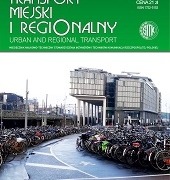Abstract 1/2018
Table of content
Sylwia Pogodzińska – Estimation of bicycle traffic flow based on bike share system data
Remigiusz Wojtal – Air pollution in cities in the aspect of car traffic
Paulina Bździuch, Marek Bogacki – Emission of heavy metals into the air from urban buses in Krakow in 2010-2025
Aleksandra Faron – Relations between planning of the city’s buildings structure development and the transport system based on the example of Krakow
Ewelina Berlińska, Jan Choma – Implication of innovative mobile applications that streamline urban mobility to implement sustainable transport concepts and the SmartCity concepts
Abstracts
Sylwia Pogodzińska
Estimation of bicycle traffic flow based on bike share system data
Abstract:The article presents a method of estimation of bicycle traffic flow based on the GPS data from bike share system. Analyses have been made for the city of Krakow, using daily traffic data from 5 automatic counter loops and the GPS data from bike share system called Wavelo. Based on the two-factor analysis of variance (ANOVA) and the Tukey post-hoc test, the influence of “localization” and “day of the week” factors on the share of Wavelo bicycles in the entire bicycle flow was estimated. It has been proved that examined share is not significantly different between individual days of the week, but changes significantly between analyzed locations. Developed models are characterized by the high R2 coefficients (exceeding 0.90) and average error of estimation up to 11.5%. The results of the studies show that bicycle traffic flow can be estimated based on the GPS data provided by bike share system. However, it is necessary to carry out control measurements to verify developed models and their possibilities of application in bicycle traffic flow estimation in other locations.
Key words: bicycle traffic flow, bike share system, GPS data, Wavelo
Remigiusz Wojtal
Air pollution in cities in the aspect of car traffic
Abstract: Air pollution in the cities has become a significant problem, especially in the autumn and winter seasons. Harmful compounds such as carbon monoxide, nitrogen oxides and particulate matter PM10 and PM2.5 are emitted by different sources, and one of them is excessive road traffic. Although the combustion vehicles emit mainly oxides, their increasing number resultes with significant impact on the share in air pollution by particle matter.
Key words: air pollution, smog, particulate matters, road traffic
Paulina Bździuch, Marek Bogacki
Emission of heavy metals into the air from urban buses in Krakow in 2010-2025
Abstract: Road transport is a source of heavy metals emissions into the air resulting with an increase concentrations of these pollutants in the air and soil pollution along road routes. Heavy metals are emitted both from the process of fuel combustion in car engines, as well as the tire and brake abrasion. This article shows the results of research on changing value of emission of: lead (Pb), cadmium (Cd), copper (Cu), chromium (Cr), nickel (Ni), selenium (Se) and zinc (Zn), from urban buses which operated in the Krakow metropolitan area in 2010-2015, and the forecast for 2017, 2020 and 2025. Emissions’ calculations for 2010-2015 have been made based on the actual operational data of Krakow buses, provided by two carriers: Municipal Transport Company (Miejskie Przedsiębiorstwo Komunikacyjne S.A.) in Krakow and Mobilis sp. z o. o. Prognostic calculations (2017-2025) took into account the plans of carriers including fleet modernization activities. The results of annual values calculations of emitted heavy metals are demonstrated in the maps presenting the spatial distribution of annual emissions levels on the area of municipalities of the Krakow agglomeration, as well as along road routes where the buses of analyzed fleet were operating.
Key words: urban public transport, heavy metals, air pollution, emission inventory
Aleksandra Faron
Relations between planning of the city’s buildings structure development and the transport system based on the example of Krakow
Abstract: The dynamic growth of cities, which have been observing for last years, has an significant impact of the road network function. New traffic generators such as housing estates, commercial or industry developments, have visible impact on the street network traffic and public transport condition. Activities of the city devoted for the development of transport systems, should be focused on the planning of the function-spatial city structure. One of the most effective public transport means is track transport (rail, tram and metro), where the development of land surrounding the track transport stops and station, should be planned with the special care and attention. Mainly this way we can ensure a high passenger potential for those systems. This article is a result of the project “Spatial structure model of Krakow. Planning perspective” for the Municipality of Krakow freelance agreement, where the author of this article was the member of authors group.
Key words: transport systems planning, spatial development planning, sustainable transport
Ewelina Berlińska, Jan Choma
Implication of innovative mobile applications that streamline urban mobility to implement sustainable transport concepts and the SmartCity concepts
Abstract: In the age of rapid development of the IT industries and mobile technology, as well as significant urbanization of cities and a growing number of cars per capita, traffic congestion is rapidly increasing. Nowadays, creating and deploying mobile and web applications that improve the mobility in cities are very important. Areas of efficient urban traffic are dealt with urban logistics, and in the particular implementation of the concept of Sustainable Urban Transport Project and the concept of intelligent cities – SmartCity. One of the most important objectives for urban management is to change behaviors of the population in terms of their transportation choices – from the transport of an individual car to public transport, which reduces the intensity of urban congestion and greatly improve this process. The aim of this article is to review the knowledge of the above mentioned concepts and to review the most popular mobility applications. Authors using the survey questionnaire examined the level of use of particular mobile applications considering their usefulness and frequency of use by respondents.
Key words: SmartCity, city logistics, logistics, transport, Sustainable Urban Transport Project

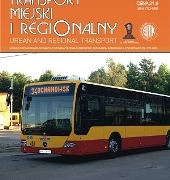 SITK RP
SITK RP 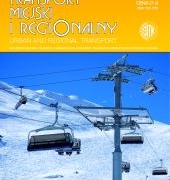 SITK RP
SITK RP 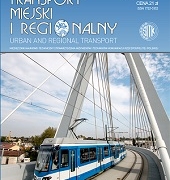
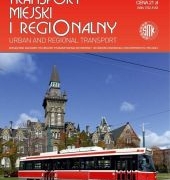 SITK RP
SITK RP 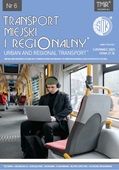 SITK
SITK 